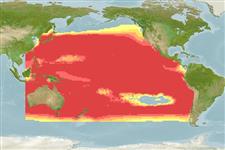Classification / Names
Common names from other countries
Main reference
Size / Weight / Age
Max length : 300 cm FL male/unsexed; (Ref. 9340); common length : 200 cm FL male/unsexed; (Ref. 9340); max. published weight: 450.0 kg (Ref. 47525); max. reported age: 15 years (Ref. 83312)
Environment
Marine; brackish; pelagic-oceanic; oceanodromous (Ref. 51243); depth range 1 - 200 m (Ref. 58302)
Climate / Range
Subtropical, preferred 27°C (Ref. 107945); 52°N - 50°S, 112°E - -77°W
Distribution
North Pacific: Gulf of Alaska to southern California and Baja California and from Sakhalin Island in the southern Sea of Okhotsk south to northern Philippines. There are four substantiated records of this subspecies in the southern hemisphere: off Western Australia, southeast Pacific (37°11'S, 114°41'W) and Gulf of Papua (Ref. 10997). The species occurs mainly in the northern Pacific but ventures into New Zealand waters for at least three months during spring and early summer (Ref. 83312).
Countries | FAO areas | Ecosystems | Occurrences | Introductions
Short description
Mean number of gill rakers 35.9. First ventrally directed parapophysis on vertebra number 8. Dorsal wall of body cavity has a narrow bulge with lateral concavity and wide lateral trough. Caudal keels dark.
IUCN Red List Status (Ref. 115185)
Threat to humans
Harmless
Human uses
Fisheries: highly commercial; aquaculture: commercial; gamefish: yes
More information
ReferencesAquacultureAquaculture profileStrainsGeneticsAllele frequenciesHeritabilityDiseasesProcessingMass conversion
Tools
Special reports
Download XML
Internet sources
Estimates of some properties based on models
Phylogenetic diversity index
PD50 = 0.5039 many relatives (e.g. carps) 0.5 - 2.0 few relatives (e.g. lungfishes)
Trophic Level
4.5 ±0.3 se; Based on size and trophs of closest relatives
Resilience
Medium, minimum population doubling time 1.4 - 4.4 years (tm=3-5; tmax=15; K=0.1-0.2)
Vulnerability
Very high vulnerability (76 of 100)
Price category
